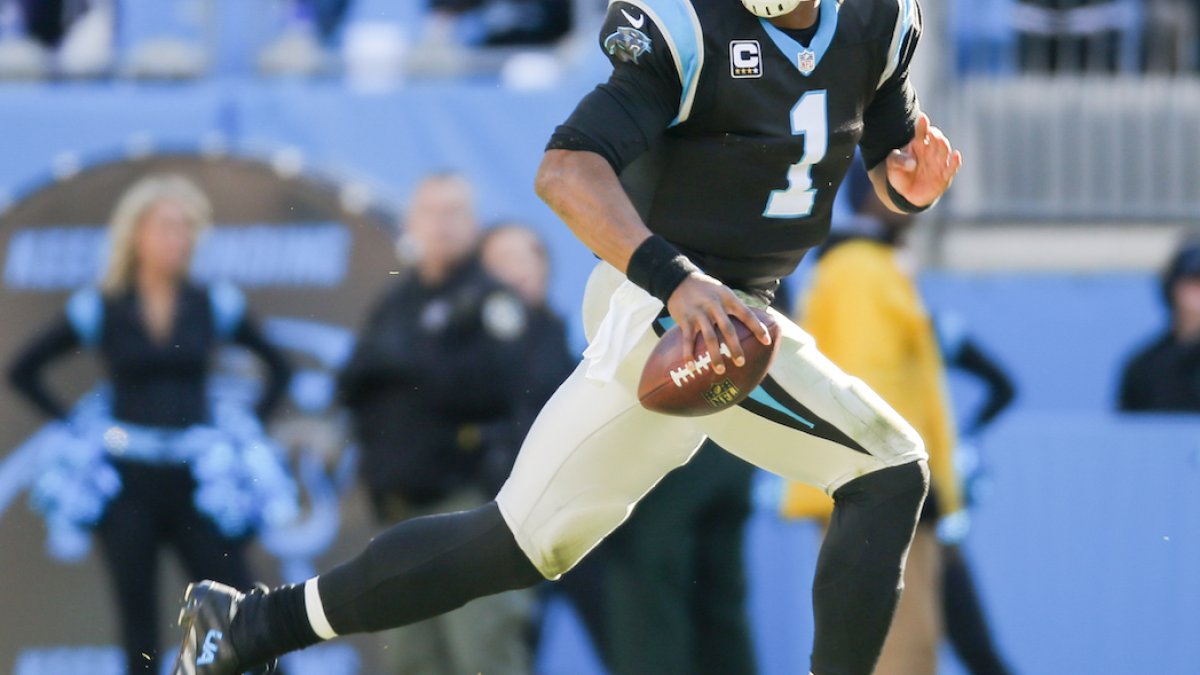A few weeks ago, we explored the narrative of whether or not a flashy new teammate helps a team’s existing No. 1 wide receiver by “taking the pressure off.”
Today’s narrative is a close relative.
The narrative: Rushing quarterbacks help their running backs because they “open things up.”
On the surface, this narrative makes plenty of sense. Defenses do have to account for rushing quarterbacks, which theoretically should make it easier for the running back (at least on some plays) to find a lane. For example: Perhaps a defensive end is only supposed to go after the quarterback on read-options.
Does the narrative hold up?
The research
Defining a “rushing quarterback” can be a bit tricky. Sure, Cam Newton is a rushing quarterback. So is Russell Wilson. But what about Aaron Rodgers, or Andrew Luck? What about Jameis Winston or Marcus Mariota? How about Andy Dalton? You laugh, but only Cam Newton (34) has more rushing touchdowns than Dalton (17) since 2012.
So instead of subjectively picking “rushing quarterbacks” and then looking at their team’s running back production, this piece examines league-wide correlations between quarterback rushing stats and running back rushing stats from 2012-2016.
The findings
- The relationship between the percentage of all team rushing touchdowns scored by a quarterback, and the average number of attempts per touchdown for that team’s running backs.
In other words, if a team’s quarterback accounts for an increasingly higher percentage of the team’s total rushing touchdowns, does that same team’s running back score touchdowns less often?
This is the “yeah, but” of the narrative. If the narrative is true — and a rushing QB “opens things up” for the team’s running back — then the rushing QB is also probably vulturing some touchdowns.
But upon further inspection, there isn’t much correlation between these two stats. The R-squared of this relationship is just 0.01.
It’s hard to say why exactly this has such weak correlation, because it seems to make plenty of sense. The most logical explanation would be that the quarterbacks aren’t vulturing touchdowns from the running backs — they are vulturing touchdowns from themselves (taking what would have been passing touchdowns and instead converting them into rushing touchdowns for themselves).
- The relationship between a team’s quarterback rushing YPC, and the team’s running back YPC.
Logic holds that if a team has a “rushing quarterback,” then, in general, that quarterback’s average rushing YPC will be higher than a team with a pocket passer. So this provides us with another way to test the narrative at a macro level.
There’s actually a slightly negative correlation when examining this relationship, with an R-squared of -0.09. This means that the higher a team’s quarterback rushing YPC, the lower the team’s running back YPC.
- The relationship between the percentage of all team rushing attempts handled by the quarterback and that team’s running back’s average YPC.
Again, logic holds that if a team has a “rushing quarterback,” he will handle a larger percentage of that team’s carries than a non-rushing quarterback would. This gives us another avenue to examine this narrative from a macro level.
We did discover some positive correlation between these two stats, but again with an extremely low R-squared (.02).
The amount of rushing attempts (relative to total attempts) a team’s quarterback shoulders himself appears to have little to no bearing on that team’s running back’s ability to gain additional yardage.
The verdict
We laid out three of the correlations studied above, and all of them showed weak correlations, at best. The highest R-squared observed was just 0.08. We studied other correlations — including a direct correlation to a running back’s fantasy points per carry — and found more of the same.
Please remember that we tackled this narrative from a league-wide macro level. Studying individual situations comes with far too many variables to be sound from a research perspective. But after diving into five full seasons’ worth of rushing data, we found little (or no) correlation between positive quarterback rushing metrics and positive running back rushing metrics.
In short, this narrative is busted.
But while the narrative is busted, note also that it didn’t prove the opposite of the narrative either. In other words, having a rushing quarterback doesn’t appear to help the team’s running back — but it doesn’t hurt the team’s running back either.



 © 2025 PFF - all rights reserved.
© 2025 PFF - all rights reserved.